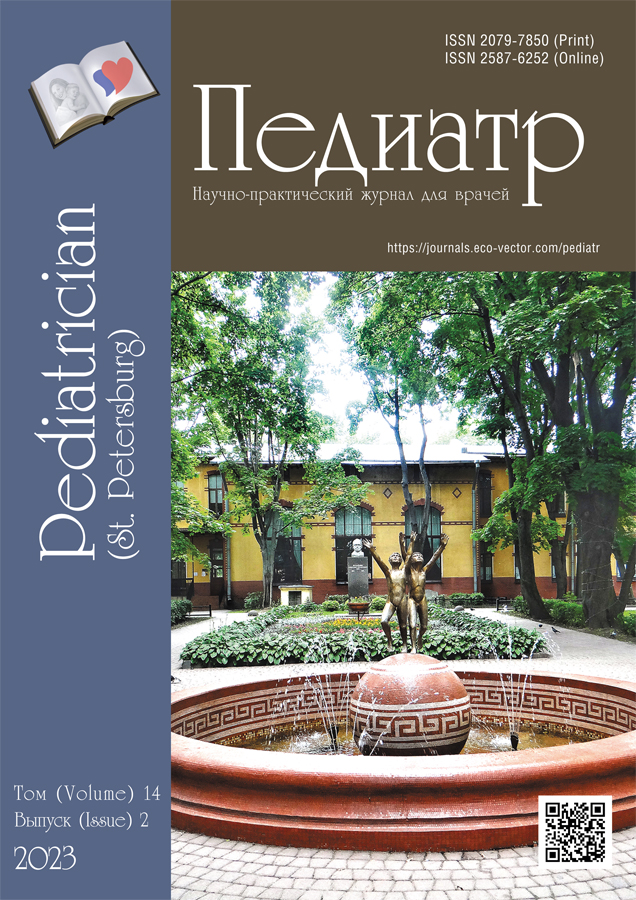Fetal valproate syndrome (review and case report)
- Authors: Melashenko T.V.1, Palchik A.B.1
-
Affiliations:
- Saint Petersburg State Pediatric Medical University
- Issue: Vol 14, No 2 (2023)
- Pages: 117-125
- Section: Clinical observation
- URL: https://journals.eco-vector.com/pediatr/article/view/530231
- DOI: https://doi.org/10.17816/PED142117-125
- ID: 530231
Cite item
Abstract
Toxic damages in fetuses and newborns rank highly in perinatal pathology structure, though their true importance is not understood thoroughly. Among toxic encephalopathies of newborns the accent should be given to the conditions caused by administration of medicines by a pregnant woman. The use of medicines, especially neurotropic, during pregnancy is often forced. The widespread prevalence of epilepsy in women of reproductive age leads, in certain cases, to anticonvulsants administration during pregnancy. The dominance of valproic acid in epilepsy treatment in recent decades requires studying its teratogenic effect in newborns — fetal valproate syndrome. The fetal valproate syndrome has casuistic nature and polymorphic phenomenology.
The clinical case study is presented of a newborn with fetal valproate syndrome (born to a mother who took valproic acid in dose 14 mg/kg per day or 750 mg per day while pregnant, due to Janz syndrome), confirmed by valproic acid presence in the blood of a newborn (47.36 µmol/l), with the main clinical manifestation of incomplete cleft palate (hard and soft) without other typical disturbances.
Most anticonvulsants have a teratogenic effect, and may cause malformations and toxic encephalopathies in fetus and newborns. The similarity of clinical manifestations of intrauterine exposure to various anticonvulsants is associated with the presence of common metabolic links (epoxy and dihydrodiol derivatives of phenytoin, phenobarbital and carbamazepine). In spite of similarity of some teratogenic effect mechanisms, the anticonvulsants nature introduces specific clinical manifestations of these disorders.
Keywords
Full Text
About the authors
Tatyana V. Melashenko
Saint Petersburg State Pediatric Medical University
Email: melashenkotat@mail.ru
SPIN-code: 7069-1730
MD, PhD, Perinatal Centre
Russian Federation, Saint PetersburgAlexander B. Palchik
Saint Petersburg State Pediatric Medical University
Author for correspondence.
Email: xander57@mail.ru
SPIN-code: 1410-4035
MD, PhD, Dr. Sci. (Med.), Professor of the Neonatology with Courses of Neurology and Obstetrics-Gynaecology Department
Russian Federation, Saint PetersburgReferences
- Guzeva VI, Belousova ED, Karlov VA, et al. Ehpilepsiya u detei. Guzeva VI, editor. Federal’noe rukovodstvo po detskoi nevrologii. Moscow: OOO “MK”, 2016. (In Russ.)
- Ziganshin AM, Kulavskii VA, Vashkevich AG. Pregnancy and epilepsy. Russian Bulletin of Obstetrician-Gynecologist. 2019;19(3):43–48. (In Russ.)
- Klassifikatsiya posledstvii perinatal’nykh porazhenii nervnoi sistemy u detei pervogo goda zhizni (metodicheskie rekomendatsii). Moscow, 2007. (In Russ.)
- Palchik AB, Shabalov NP. Toksicheskie ehntsefalopatii novorozhdennykh. 3th ed. Moscow: MEDPRESS-inform, 2013. 176 p. (In Russ.)
- Palchik AB, Shabalov NP. Toksicheskie porazheniya nervnoi sistemy novorozhdennykh neirotropnymi medikamentami. Guzeva VI, editor. Federal’noe rukovodstvo po detskoi nevrologii. Moscow: “MK”, 2016. P. 77–86. (In Russ.)
- Palchik AB, Shabalov NP. Toksicheskie ehntsefalopatii novorozhdennykh. In: Rukovodstvo po perinatologii. Ed. by D.O. Ivanov. Vol. 2, iss. 116. Saint Petersburg: Inform-navigator, 2019. P. 1142–1174. (In Russ.)
- Brazelton TB. Neonatal behavioural assessment scale. 2nd ed. Clinics in developmental medicine, N88. London: Spastics International Medical Publications, 1984.
- Clayton-Smith J, Bromley R, Dean J, et al. Diagnosis and management of individuals with Fetal Valproate Spectrum Disorder; a consensus statement from the European Reference Network for Congenital Malformations and Intellectual Disability. Orphanet J Rare Dis. 2019;14:180. doi: 10.1186/s13023-019-1064-y
- Hanson JW, Smith DW. The fetal hydantoin syndrome. J Pediatr. 1975;87(2):285–290. doi: 10.1016/S0022-3476(75)80604-4
- Herbert MR, Ziegler DA. Volumetric neuroimaging and low-dose early-life exposures: loose coupling of pathogenesis-brain-behavior links. Neurotoxicology. 2005;26(4): 565–572. doi: 10.1016/j.neuro.2005.01.002
- Hill RM, Verniaud WM, Horning MG, et al. Infants exposed in utero to antiepileptic drugs. A prospective study. Am J Dis Child. 1974;127(5):645–653. doi: 10.1001/archpedi.1974.02110240031002
- Kuni U, Adab N, Vinten J, Clayton-Smith J. Dysmorphic features: an important clue to the diagnosis and severity of fetal anticonvulsant syndromes. Arch Dis Child Fetal Neonatal Ed. 2006;91(2):F90–F95. doi: 10.1136/adc.2004.067421
- Morell MJ. Guideliness for care of women with epilepsy. Neurology. 1998;51(5S4): S21–S27. doi: 10.1212/WNL.51.5_Suppl_4.S21
- Morrow J, Russell A, Guthrie E, et al. Malformation risks of antiepileptic drugs in pregnancy: a prospective study from the UK Epilepsy and Pregnancy Register. J Neurol Neurosurg Psychiatry. 2006;77(2):193–198. doi: 10.1136/jnnp.2005.074203
- Mutlu-Albayrak H, Bulut C, Çaksen H. Fetal Valproate Syndrome. Pediatr Neonatol. 2017;58(2):158–164. doi: 10.1016/j.pedneo.2016.01.009
- Omtzigt JG, Los FJ, Grobbee DE, et al. The risk of spina bifida aperta after first-trimester exposure to valproate in prenatal cohort. Neurology. 1992;42(4S5):119–125.
- Practice parameter [RETIRED], Management issues for women with epilepsy (summary statement). Report of the Quality Standard Subcommittee of the American Academy of Neurology. Neurology. 1998;51(4): 944–948. doi: 10.1212/WNL.51.4.944
- Volpe JJ. Neurology of the newborn. 5th ed. Philadelphia: Elsevier, 2008.
- Wegner С, Nau H. Alteration of embryonic folate metabolism by valproic acid during organogenesis: implications for mechanism of teratogenesis. Neurology. 1992;42(4S5):17–24.
Supplementary files








